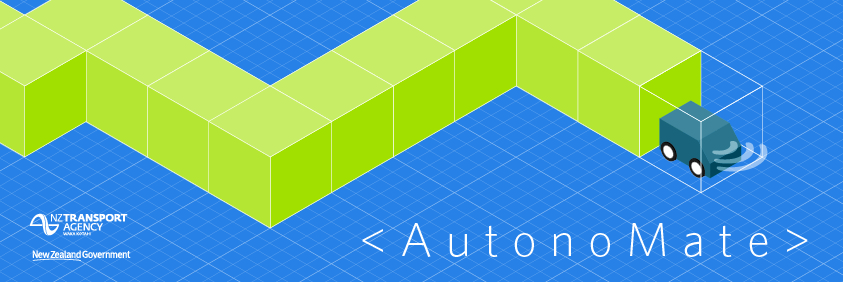Access keys for nzta.govt.nz
- h Home
- m Menu
- 0 Show list of access keys
- 2 Skip to content
- 3 Skip to top
AutonoMate, a new Digital Technologies curriculum resource for Years 9-10, activates design thinking around the future of transport.

Possums are better off dead, for the sake of New Zealand’s wildlife. Most people would agree but mashing that thought into the global debate around autonomous vehicles was the creative leap taken by a high school student in Queenstown.
Last year, the NZ Transport Agency’s Innovation Lab visited Wakatipu High School for an AutonoMate workshop on future transport, says Fiona Millar, the Lab’s Community Lead.
‘This particular student came at the topic from very real concerns about the environment, but not in a way anyone expected. He wanted to know if an autonomous vehicle would be able to recognise and avoid his pet cat, but still do its bit by hitting possums on the road.
‘I don’t think anyone working in this field had thought of that.’
This exchange exemplifies the aim of the Lab’s AutonoMate education programme, to get the next generation involved in our collective conversation about the future of transport and mobility.
AutonoMate features a curriculum resource for Year 9-10 students, free to download from the Transport Agency’s Education Portal.
This resource integrates Digital Technologies progress outcomes with achievement objectives in English and Social Studies.
The context is a design thinking project about the challenges and opportunities of emerging mobility technologies. Options include:
Fiona says the Lab’s goals include getting young people engaged in STEM careers focussed on societal problem-solving.
‘We would love to see a bigger pipeline of people wanting to not just upskill in technology but apply themselves in the public sector on those big systemic challenges around the environment and access and safety.’
Download the curriculum resource:
AutonoMate: Future of Mobility
The Innovation Lab has a small set of Edison Bots that can be loaned to schools for the technology components of the unit. The team is also happy to discuss engagement experiences for schools.

Andy Crowe
Educational resource developer Andy Crowe wrote the AutonoMate curriculum resource. He says it takes students through design thinking, with emphasis on prioritising problems.
‘If we are trying to create a more innovative society in the long run, a big differentiator will be having young people who can solve the right problem, not just work on their own inkling of what it might be. I work with how young people can become problem finders.’
AutonoMate opens up contemporary contexts for such learning, such as the so-called first and last mile of journeys.
‘There’s a gap in public transport, the need to figure out how I get from my front door to the bus stop. Here’s a real problem that companies are trying to make solutions for, so why not put it in front of 14 to 15-year-olds and find their perspective on how it might be solved.’
By marrying context to a design process, teachers gain a structure to scaffold student thinking, says Andy.
‘You can trust your students to be the managers of the ideas that come from the classroom while still holding them accountable. And teachers are good at that, at getting the best out of young people.’
Fiona reiterates that transport is a context that connects with the concerns of young people at a time when their diverse viewpoints need to be understood.
‘The future of transport is about impacts on sustainability and the environment; about choice, accessibility and inclusion; which all allow participation in society. We need more diversity in who gets involved in this conversation, and through AutonoMate so far, we’ve seen this age group are ready to be involved. They want to look at transport and mobility in a wider global context of those big issues that many of them feel really passionate about.’
A version of this article first ran in Interface magazine: